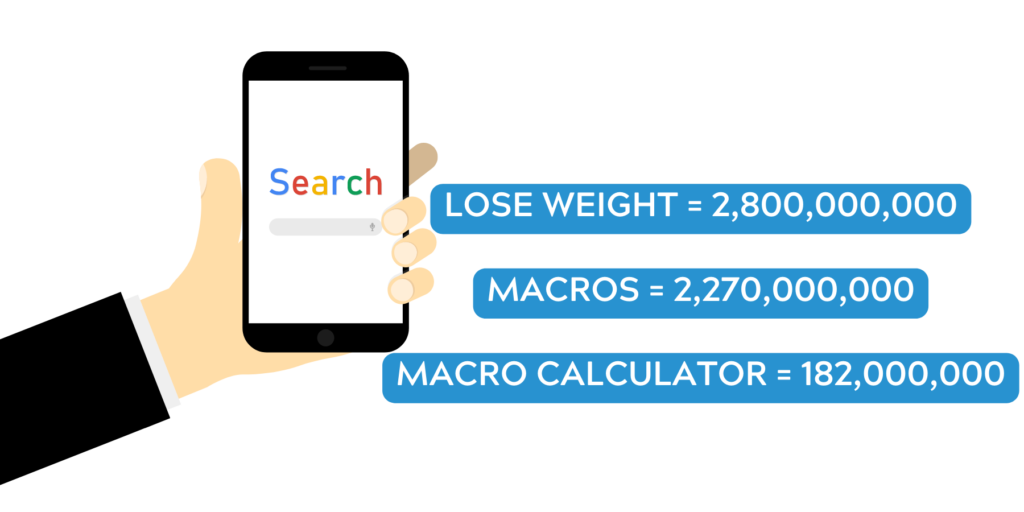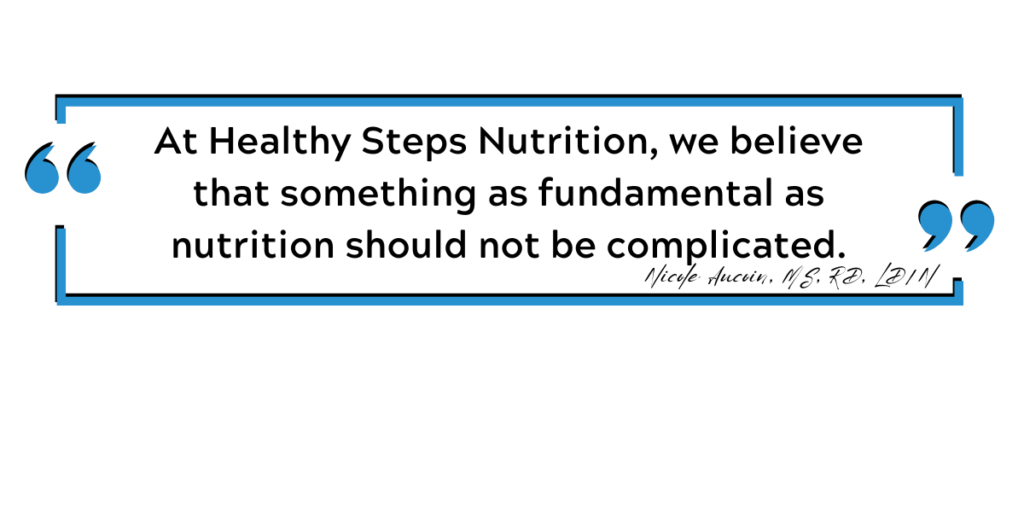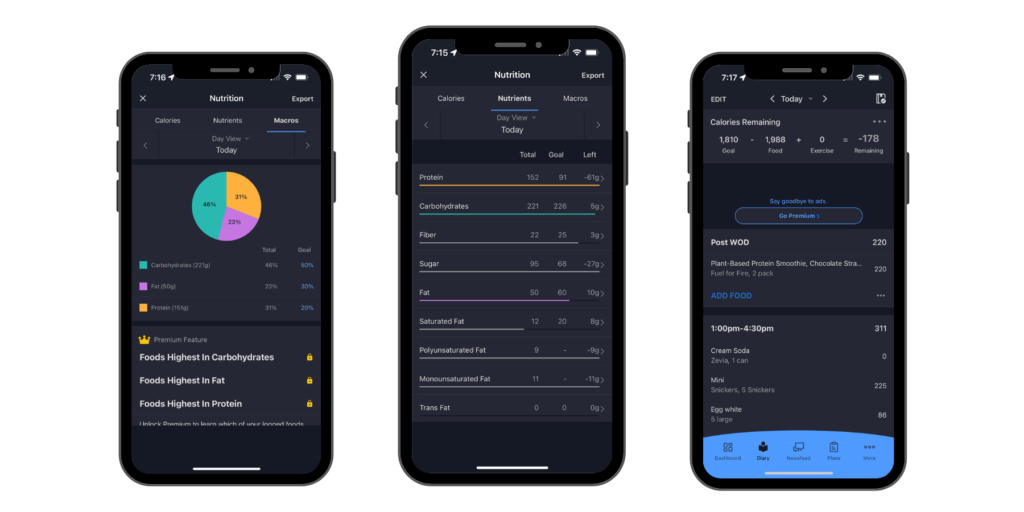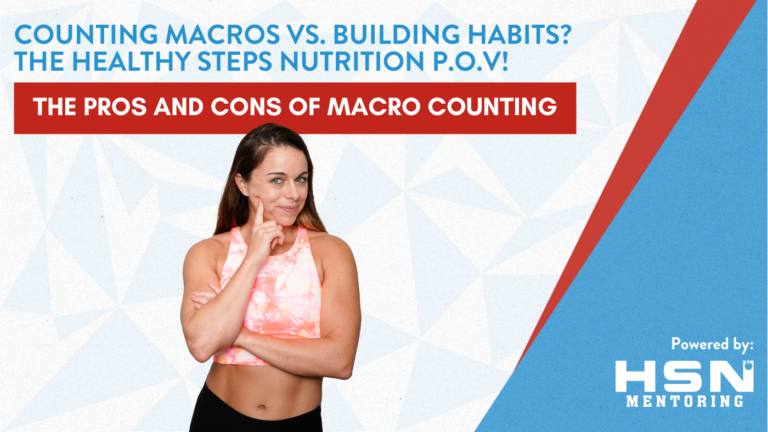If you have been around the nutrition and fitness industry for any period of time, you have probably heard the term “counting macros.” Alternatively, you may have heard “if it fits in my macro,” “macronutrient ratios,” “macros for weight loss,” “flexible dieting,” “calorie deficit,” “macro diet,” or “macro counting.”
In addition to these terms, you have also probably heard references related to intuitive eating, counting calories, and hand portion guides.
For the most part, these terms are centered around the discussion of someone either needing to lose weight or gain weight. Most people know that in order to gain wait, you need to eat more food, and in order to lose weight, you need to eat less food.
What many folks don’t understand is how to best monitor their food intake in a way that works for them and their goal.
When people search the term “lose weight” on the internet – 2,840,000,000 results pop up in less than a second. The same goes for the term “macros.” It’s no surprise that we end up with a bunch of nutrition confused people in this world doing nothing to improve their health because they are overwhelmed and don’t know where to start.

To put the icing on the cake :), qualified nutrition and wellness experts all have varying opinions. Some will say calorie counting and macro counting is the only way to go. Others will suggest listening to the body and implementing a more mindful type eating approach. Many swear by estimating portions.
The fact of the matter is; all of these approaches work if practiced consistently. But, what doesn’t work is forcing ourselves (or your clients) to practice one way over the other, and assuming a one fits all approach.

We have found with the thousands of clients we have helped with our program that 95% of them are most successful when starting their nutrition journey with a habit based approach vs. counting macros.
Our Basics Of Nutrition Coaching Certification Course teaches the fundamentals of nutrition and all about the “macros.” to potential coaches. We also provide education on counting macros and how to teach clients about this method.
This being said, our primary focus with our course and training coaches is ensuring every client they see has developed a good strong foundation of healthy habits that stick, before counting macros is ever introduced.
In this blog post, we will break down the pros and cons of counting macros and discuss why we choose to help clients develop habits first.
What Is Counting Macros?
“Macros” in short stands for the term macronutrient. Macronutrients make up our food and are what fuel our bodies. They consist of proteins, carbs, and fats and each gram of a macro is worth so many calories.
Counting macros is a term that describes an individual keeping track of or counting the number of macronutrients they consume in a day. They may be monitoring this number just because they want to know, but predominantly it is used as a method to lose fat or gain weight and muscle mass.
With macro counting, a set number of macros are assigned each day for a person to consume predominantly based on their weight, height, activity level, and overall goal. The total number of macros are broken down into grams of each macronutrient the person should consume in a day. From there the person breaks that entire number down into smaller numbers to consume at each meal.
Counting macros is similar to counting calories. What differentiates them is the fact that when a person keeps track of their calorie intake, specific macronutrient ratios don’t matter. Only the calorie count matters.
Check out the below picture that illustrates the difference in how food is tracked by a person counting calories vs. counting macros.
This client needs to eat 1810 calories per day. You can see by the picture that if they are tracking macros – those calories need to come from all three macronutrients.
If they were counting calories alone, the macros don’t need to be consumed in any certain split. There is no specification on how many carbs, proteins or fats the person should consume. Let’s hope those calories don’t all come from fat – but who knows?
I think what is important to take away here is the fact that in both of these situations, keeping track of macros and/or calories is a lot of work.
What Are The Pros And Cons Of Counting Macros, And Who Does It Work For?

Let’s start with all the positive things about counting macros. Just because our primary focus is not on teaching macro counting with our clients doesn’t mean that it’s altogether bad. We see value in all many types of nutrition coaching strategies when they are appropriate for the client.
Pros Of Macro Counting
Macro counting, WHEN DONE CORRECTLY, is precise.
Because people are weighing, measuring, and recording everything they consume each day, the level of precision is much higher than when estimating the amount of macronutrients consumed.
Food Tracking works, WHEN DONE CORRECTLY.
In the linked study, participants were required to track their fat calories and macros daily plus log the rest of their food in a journal. The conclusion of the study indicated that the people who tracked the most consistently were the ones who lost the most weight.
It provides food education.
This is one of my favorite pros when it comes to tracking macros. In doing so, a person gets an amazing education on what the foods they eat actually contain from an ingredient standpoint to a volume standpoint.
Weighing and measuring food every day provides great insight into how much 3oz of ground beef really looks like or what an actual true serving of cereal is. When considering eating out, people can’t believe that the one big mac they had at McDonald’s on the weekend actually contained 33grams of fat alone. That didn’t even include the fries!
Cons Of Macro Counting
It’s extremely tedious and time consuming.
This is coming from a former consistent macro tracker! You got it – ME!
I used to consistently and accurately track my macros on a daily basis. The only time I didn’t log was when I was on vacation.
Remember when I said a few paragraphs ago that macro counting is precise WHEN DONE CORRECTLY. Well, to be done correctly, you must weigh and measure everything single thing you put in your mouth and record it in an app or some other tracking platform.
Yes, every BLT – or bite, lick, and taste must be tracked and logged.
If a person eats the same amount and type of food repetitively, then tracking macros becomes easier because those foods are typically saved in the app they use. However – when new foods and amounts are introduced, the tracking is time consuming again because there needs to be new foods added to the tracking app, which requires a library search, and manual addition if the food isn’t loaded. We haven’t even mentioned logging recipes yet! That’s a whole other ball game.
Regardless of the fact that tracking becomes habitual over time, it is still time consuming. And if you forget to track immediately, the chance that you are going to accurately remember your earlier food intake at the end of the day is slim to none.
Inevitably you will leave something out.Macro tracking can affect a social life.
People who track accurately and are social or traveling find it very challenging. Food is oftentimes the center of being social. It brings us together on holidays, and when people go on dates or interact with friends the occasions are often centered around a meal.
For someone who is tracking their macros, these meals can become very hard to track accurately. If tracking is not accurate – there is really no sense in tracking. So what we oftentimes see as nutrition coaches, are clients bowing out of social events that are otherwise great for their mental health and social lives, all because they won’t be able to accurately track their macros.
This leads to depression and isolation, which in general is just not a great situation.
Can be detrimental for someone who has disordered eating patterns.
Studies have shown that for someone with disordered eating patterns, tracking macros or tracking calories can contribute to the overall disordered eating.
Disordered eating patterns don’t always have to be extreme to be labeled disordered eating. Simply being over fixated on the quantities of food you are eating or feeling like you are always trying to limit the amount of food you eat in order to still get the results you are looking for can be considered an eating disorder.
Regardless of how extreme the disorder is, studies like the above and the experience the R.D.’s at Healthy Steps Nutrition have from seeing 100’s of clients confirm, that many times this type of tracking can be troublesome for individuals with a history of disordered eating.
Nutrient dense foods and diet quality are not always considered when tracking macros.
Have you ever heard someone who is macro counting say “well it fit my macros so I ate it?”
What they are referring to is the situation where they disregarded the actual quality of food they put in their bodies simply to make their macro ratio work. Unhealthy foods are often eaten rather than healthy foods when people count macros simply because they are more convenient for people who haven’t developed healthy habits such as meal prep.
They eat what is available quickly rather than focusing on food quality. Are they ultimately reaching the amount of calories/macros they are allotted to eat during the day?
Yes.
But are they fueling their body with the most nutritious foods that will help stave off disease and chronic health disorders?
No.
Who Is Macro Counting For?

Because of the complexity and time required to track macros accurately, we have found that macro counting isn’t great for that many people.
Most of the clients that come to us are not interested in weighing and measuring food every day in order to be healthy. And we agree that there are other methods to try first that can provide amazing results.
So then, who may like macro counting?
Clients with specialized needs.
From our experience, situations that require macro counting have been related to clients training for a specific athletic pursuit that requires them to guarantee themselves they have enough fuel to get through their training and for their main events.
Examples of this are long distance runners, those running triathlons or iron mans, and many competitive Crossfit athletes.
These people have advanced beyond learning healthy habits. Their habits are, in fact dialed in, which makes it so we feel comfortable with introducing macro tracking to help them take their fitness to the next level.
After these clients complete their race or athletic events, the majority of them go back to using other methods to monitor their food consumption than counting macros.
Super analytical people who love numbers.
If you are the type of person that LOVES numbers, and keeping track of this type of data is exciting, macro counting could be a good fit. Because being analytical is a personality trait, weighing and measuring food in order to log something 100% accurately could make the heart sing.
Someone, like a nutrition client, who is simply tracking short term to learn what certain measurements of foods look like.
As I stated previously, I love this part of macro tracking. I do, in fact believe that at some point in a client’s journey, it is beneficial to track macronutrients for a day just to learn exactly what one 4oz serving of ground turkey looks like, or what 28g of oatmeal actually is.
Clients who are simply not seeing any results with the other methods they have tried.
In certain situations, no matter what strategies a nutrition coach uses, there will be those clients that just simply don’t see results. Typically this comes down to the client not being consistent with their efforts. On certain occasions, people experiencing this could use the benefit of understanding the value of a more in depth look at what they are consuming and so we will try for a short period of time, learning macros.
If this scenario describes you as a client – it’s time to reflect! Are you being consistent in your efforts? Do you really want to build this life of wellness? Talk to your coach, revisit your why’s and make a new plan for consistency!
Now if you are consistent and there is no change, we will suggest turning to a qualified health professional to get some blood work done as our next step.
Why We Choose Habit Based Coaching First

Like we stated above, at Healthy Steps Nutrition, we believe that something as fundamental as nutrition should not be complicated.
In our opinion, starting a nutrition and wellness journey with macro counting makes nutrition complicated.
Habit based nutrition coaching focuses on repeating small daily actions that eventually lead to being successful at a long term goal. When one habit is learned and sticks, another is added on top of the learned habit. This habit based approach can really be used to be successful at anything in life, but of course, we apply it to nutrition and wellness.
Learning more than one new thing at a time sets people up for failure.
Asking a person who can’t seem to get it together enough to drink 6 oz of water each day to weigh, measure and log their meals accurately sets a lot of people up for failure. We have seen it happen many times. 81-90 percent of all new years resolutions fail because people are trying to implement too many new things at once.
In our experience success leads to motivation. When failure happens before success, motivation will never come. It’s less complicated for clients to learn one new healthy habit per week vs. five right out of the gate.
Our systems are set up to be able to hold clients accountable to their new habit. If they are successful, then another new habit is added. James Clear calls this habit stacking, and we believe in his methodology.
Habit based nutrition coaching helps take the emphasis off of the food.
The other reason we like habit based coaching first is that it takes some of the emphasis off of the food. It seems contra intuitive however many food choices are made based on emotions, time constraints, and lack of planning rather than what a person actually desires to eat. If we can use the holistic approach of building habits first, the nutrition component begins to fall into place.
All these reasons are why we lead with a habit based approach to nutrition coaching.
If advanced nutrition coaching methods are ever needed with our clients, then we will for sure explore other styles. But to start out, even with elite athletes, we focus on a habit based approach first.
Conclusion
As a nutrition client (or even a nutrition coach), we urge you to take the pros and cons of counting macros and level them up to the specific goals that are being worked towards! Ultimately it’s up to you how you start the journey and macro counting can certainly have its place at some point.
But if you are running into situations where counting macros is hard to be consistent at, there is no accuracy when tracking because there is no weighing and measuring – just logging, and there is a high level of frustration, taking a deeper dive into the habit based approach could be beneficial.
Many times we see nutrition coaches turning to macro counting for their clients because it provides the coach with a pass fail system. A client’s success or lack thereof is based on whether or not they were consistent with tracking a number in the app.
In our minds determining a client’s success goes way beyond just a number in an app. There are so many other ways to glorify it then basing it on whether or not the “macros have been met”.
But because of the lack of education in coaching habits, many coaches don’t see another way.
If you are a macro counting client reading this and you want to try a habit based approach, talk with your coach!
If you are a nutrition coach reading this, and you are new to coaching habits, we encourage you to learn a little bit about it before you write it off. We have tons of free education regarding habit based coaching that will be linked below.

In addition we also offer a habit based nutrition coaching course called the Basics Of Nutrition Coaching that will set you up for success with coaching habits. This course is the only nutrition certification course that:
Offers a practical application to nutrition coaching!
Coaches will receive 6 weeks of nutrition coaching with an HSN RD/Nutrition coach! You heard it – coaches will be the client of an HSN nutrition coach!
Ends with a nutrition coach evaluation after the certification test.
After coaches complete the certification course an R.D. from Healthy Steps Nutrition will evaluate their coaching based off of different client scenarios.
This evaluation will take about an hour and is done via zoom!
Learn More About Nutrition & Wellness
LISTEN: The Fundamental Skills Needed To Become An Effective Nutrition Coach – Inside The Basics Of Nutrition Coaching – CrossFit Preferred Nutrition Course – HERE
LISTEN: Dietitian Q&A: Most Popular Questions Answered Around Health, Wellness & Nutrition – HERE
LISTEN & WATCH: Top 3 Myths When Hiring A Nutrition Coach & How To Find The Right Coach For You – HERE






